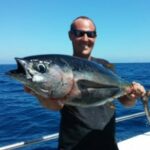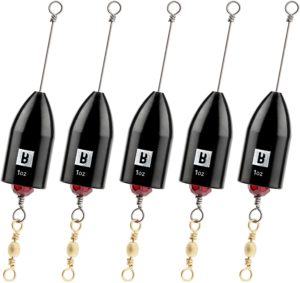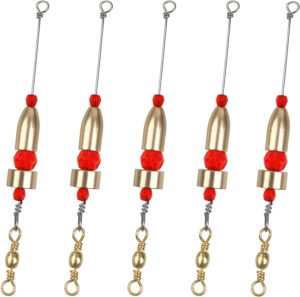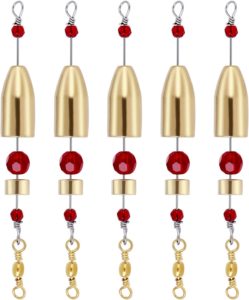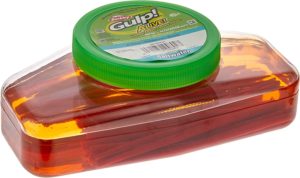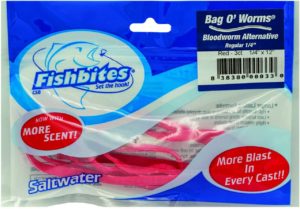Best Bait for Surf Fishing [2023 Update]
![Featured Image For Best Bait for Surf Fishing [2023 Update]](https://fishermensangle.com/wp-content/uploads/2016/03/surf-fishing-feature-1000x589.jpg)
Digging Up the Best Bait for Surf Fishing
There’s a spot along the sandy beaches of Southern California near where I grew up. Right on the border of Carlsbad and Oceanside lies this treasured stretch of shore, an incredible spot for an afternoon of inshore fishing.
Not being a huge surf spot, you will see some carrying boards. Mostly you’ll see beach goers with their blankets, umbrellas, sunscreen, and kids in tow. Many people also enjoy walking along the sand and water. While there are plenty of other choices up and down the So Cal coast, I’m fond of this particular spot. This is where I learned to surf fish. I remember dragging nice 5 lb Corbina up on the sand as a little kid. Using our families compact trout rod with 2 lb test! Starting in late spring and going until the heat starts to wear off in the fall, is when you’ll find quality surf fishing. There’s no need to stop at the tackle store, because the best bait for surf fishing will be right under your feet.
Taking Advantage of the Sand Crab Invasion
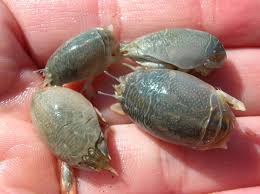 Every year usually sometime in April, marks the beginning of sand crab season along the beaches of Southern California and down into Mexico. They add a huge source of food to the fish that make their life in the shallow surf. They can be found all along the coast, where the water meets the sand. Sand Crabs (or fleas) can often be found all the way through to early fall. If you were to take a long walk on the sand, stopping to talk to surf fisherman, you’d find them using all sorts of different bait. Previously frozen shrimp, mussels, squid, sardines, or anchovies would all be in the mix. Some of these anglers will be using sand crabs, and they are always the first choice for me. Let me tell you how I find them, gather them, and use them for bait.
Every year usually sometime in April, marks the beginning of sand crab season along the beaches of Southern California and down into Mexico. They add a huge source of food to the fish that make their life in the shallow surf. They can be found all along the coast, where the water meets the sand. Sand Crabs (or fleas) can often be found all the way through to early fall. If you were to take a long walk on the sand, stopping to talk to surf fisherman, you’d find them using all sorts of different bait. Previously frozen shrimp, mussels, squid, sardines, or anchovies would all be in the mix. Some of these anglers will be using sand crabs, and they are always the first choice for me. Let me tell you how I find them, gather them, and use them for bait.
Locating Sand Crabs on the Water Line
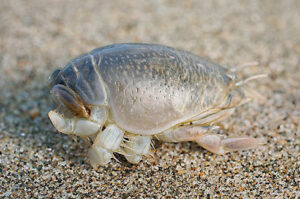 There’s times when I get down to the shore, look up and down, and see the clusters of buried sand crabs everywhere. Other times I can’t see the sign of a single one. I know there still there, but it might take more effort searching. Sometimes I see tons of them, but they’re all premature tiny crabs. Ideally you’ll be able to spot these guys, but I usually find them even when they’re hard to see. The best way to locate sand crabs is by walking where the ocean tide brings the water to stop on the sand, only to pull back out. This area of non submerged but damp sand is where sand crabs will be most often found. As the water is pulled back out leaving the sand bare, you can see their V like antennae sticking out of the sand. They usually stay in groups, which make them easier to see.
There’s times when I get down to the shore, look up and down, and see the clusters of buried sand crabs everywhere. Other times I can’t see the sign of a single one. I know there still there, but it might take more effort searching. Sometimes I see tons of them, but they’re all premature tiny crabs. Ideally you’ll be able to spot these guys, but I usually find them even when they’re hard to see. The best way to locate sand crabs is by walking where the ocean tide brings the water to stop on the sand, only to pull back out. This area of non submerged but damp sand is where sand crabs will be most often found. As the water is pulled back out leaving the sand bare, you can see their V like antennae sticking out of the sand. They usually stay in groups, which make them easier to see.
On those occasions when the tide and conditions have effectively hidden the sand crabs, I use a simple trick. I’ll walk the beach watching the sand piper birds that feed on just such creatures, then I’ll dig where I saw them looking. Not much of a trick I know, but sometimes it’s the only way to find them. You can use a mesh sift attached to a pole to help cover more sand, but I prefer to travel light when I fish the beach. This way I’m able to fish a good stretch of beach, without having to abandon or carry a bunch of gear.
Thoughts on Hand Catching Sand Crabs
When I head down to the beach to surf fish, I always wear a pair of board shorts. I make sure to buy a pair or two that have pockets. I’ll wear a hooded sweat shirt in the colder morning or evening hours, but I always have my board shorts. I’ll be digging in the sand and water, and I can fish in the water if I desire. The ocean can be a bit brisk at first even in the summer months, but is actually quite pleasant once your skin gets used to it.
Once I’ve located a patch of crabs, or an area I think might have crabs, I’ll wait till the water recedes. I then dig up a good handful of sand, flipping the sand over onto the beach next to me. If you got a few crabs in your scoop, you’ll usually see them trying to dig back in. Run your fingers through the pile of sand if you don’t see any. If you find only the tiny ones or your attempt yields no results, move a ways on the water line and try again. Also try moving a bit closer to the water, and then further from the water if having difficulty finding them.
Another thing I do with the crabs I find, is look for the ones with the orange eggs underneath. If you can find one with the eggs and a soft shell, it usually will get bit right away. I’ll discard the sand crabs that are void of eggs. I try to dig up about 15-50 of these crabs depending on how long I plan on fishing. I keep them in the pocket of my board shorts. Sand crabs stay quite fresh this way, especially if you fish in the water keeping your shorts wet.
My Set Up – Hooking the Crab – Other Bait
Surf fishermen often use the best fishing rods that are 12 foot or more. They cast far out using crabs sometimes, but more often the other baits mentioned. This is an effective way to surf fish, but not the way I do it. I’ll get a cheap 6 foot rod and reel from Amazon or Walmart. This is all I need, and it’ll last me all summer or longer. I use 4 – 6 lb test, and I tie up using the Carolina Rig. I use a size 7 barrel swivel, a size six hook, and ¼ to 1 ounce sliding egg weight to tie this set up.
Carolina Rig
The Carolina rig is ideal for both new and seasoned surf anglers.
Anglers can "feel" what's on the bottom with this pre-made Carolina rig.
These pre-rigged Carolina rigs are ideal for bloodworm lures and are particularly well suited for surf fishing.
Carolina rigs that come pre-rigged with everything you'll need when surf fishing with worm lures.
Once your set up is complete, put your rod down and head out to find a few crabs. Once you have a few in your pocket, pick your rod back up. You can hook the sand crab straight through the underside and out the shell near the head. I prefer to go through the head, with the tip and barb of the hook hidden in the underside of the crab. Once your crab is hooked, wade out in to the water or cast from shore. Now you’re fishing!
An alternate bait that works well in the surf are blood worms. Blood worms can be bought live at most tackle shops along the coast. I’ll usually buy 6 -12 worms, and pinch them in half before use. These squirmy creatures have mouths full of tiny teeth, and will surprise you if they latch on, though they don’t really hurt. I also keep a pack of imitation blood worms with me, just in case I come up empty on the sand crab hunt.
Imitation Blood Worms
If real bloodworms are unavailable, you can buy imitation bloodworms for surf fishing.
These imitation blood worms look, taste, and feel like the real thing which can surely catch some fish when you go surf fishing.
You can cut these blood worms before hooking them and go surf fishing with them.
What You Can Catch in the Southern California Surf
 The surf is a magical, beautiful place that is full of life and sound. There is so much life in fact, that tourists and even locals don’t notice it all. When you’re fishing down here, zone in. I get in a relaxed, almost meditative state when I fish the surf. I start to notice all the birds, fish in the shallow water around me, sting rays (I’ve been hit twice!), dolphin in the waves, even sharks at times. It amuses me that passers by are missing it all, and I’ll often point out some of these secrets in plain sight just to see the amazement.
The surf is a magical, beautiful place that is full of life and sound. There is so much life in fact, that tourists and even locals don’t notice it all. When you’re fishing down here, zone in. I get in a relaxed, almost meditative state when I fish the surf. I start to notice all the birds, fish in the shallow water around me, sting rays (I’ve been hit twice!), dolphin in the waves, even sharks at times. It amuses me that passers by are missing it all, and I’ll often point out some of these secrets in plain sight just to see the amazement.
It’s even better when you pull one in, and gather some outside interest. The common species that abound in this region of surf include Barred Surf Perch (the most abundant surf fish), Corbina, Spotfin and Yellowfin Croaker, Sting Rays, Sand Sharks and Leopard Sharks (both harmless to people). Halibut also stalk prey in the surf, but are more likely to be caught on live sardines, smelt, fish traps, or shiny lures like crocodiles. The best bait for surf fishing definitely changes if you want to catch the flatties.
What have you caught in the surf? What’s your preferred set up when surf fishing? Share a surf fishing story with us. We can’t wait to hear it!
As an Amazon Associate, Fishermen's Angle earns from qualifying purchases. We get commissions for purchases made through links in this post.
